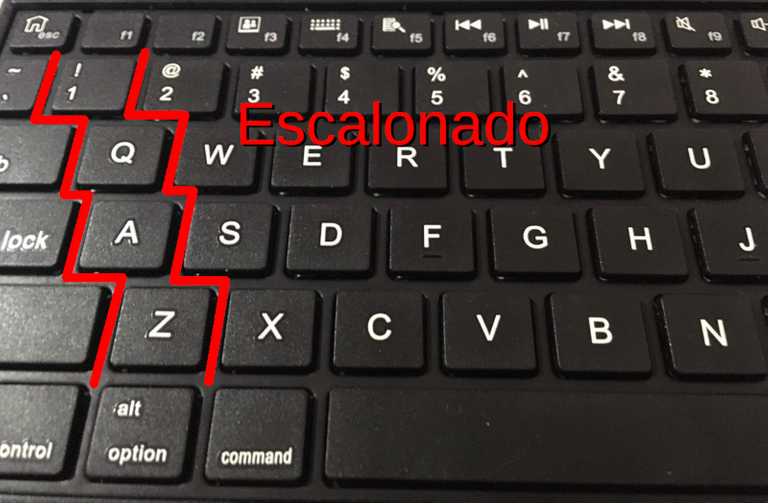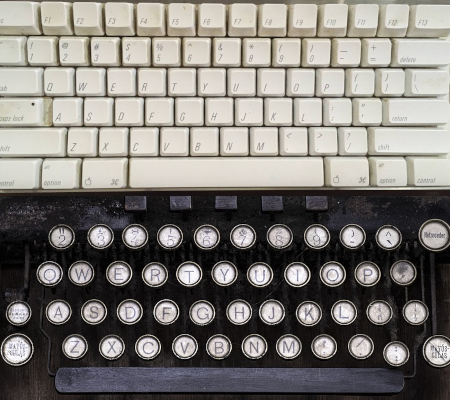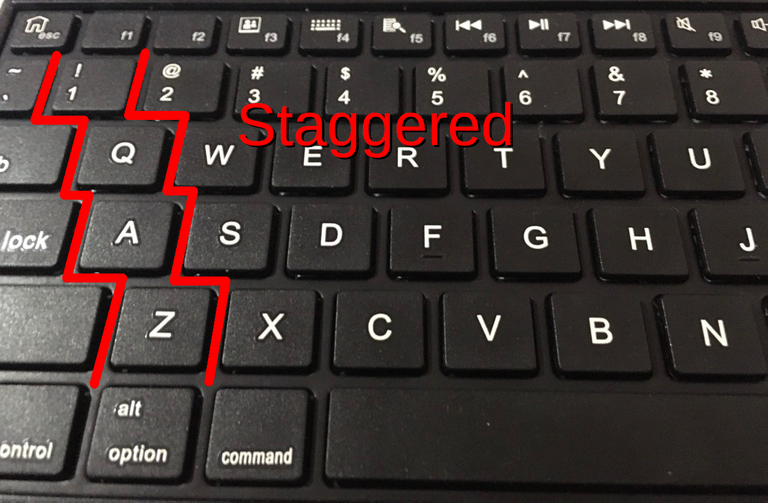Versión en español
(English version below)

Para el que le encanta trabajar, escribir y/o buscar contenido en internet, sabe lo importante y emocionante que es contar con una herramienta como lo es el teclado de la computadora. Este artefacto cuya forma puede recordar una barra de chocolate (Enserio ¿a quién no le encanta?), adornado con letras y símbolos legibles en su superficie, es una pieza o tecnología imprescindible para escribir de forma eficiente. A día de hoy, su utilidad es tan grande que incluso se ha adaptado de forma virtual a los teléfonos inteligentes con pantalla táctil, para poder escribir desde ahí.
El teclado, sin duda es un instrumento con muchísima importancia y uso, por ende, es lógico que surja la necesidad de aprender a usarlo. Sin embargo, si hay algo que es súper común, es que la mayoría de las personas que han intentado esto por primera vez, incluyéndome a mí mismo, hemos experimentado ciertas confusiones. Por hablar de un caso, una de las cosas que nos enseñan en el colegio es el alfabeto o abecedario, repetiríamos una y otra vez la pronunciación, cantaríamos canciones para recordar el orden de los signos, etc… Y cuando vamos a usar el ordenador y vemos el teclado ¿qué ocurre? ¡hay letras desordenadas por todos lados! Incluso es posible que a muchos, como me ha pasado a mí, en su infancia hayan usado un portátil educativo de juguete que tenía las teclas ordenadas alfabéticamente. Ese era fácil de usar ¿no? Si el alfabeto era nuestra referencia para saber dónde están las letras, pues, descubriremos que el teclado del ordenador no responde a ese esquema “¿En dónde estaba esta letra que ya no me acuerdo?” Más de una vez, volvíamos a mirar detenidamente hasta encontrarla.

Fuente imagen
Ese orden de letras que veíamos en el teclado no parecía tener sentido ¿verdad? Es un detalle que nos despertó confusión y curiosidad en el momento que estábamos aprendiendo. Al final, uno se acostumbra muy rápido a esta distribución de teclas, que a menudo, también olvida ese “choque” que causó ese orden, que nada tenía que ver con el abecedario del colegio.
Pero el teclado no nos ha dejado solamente ese misterio, hay otro más que es del mismo modo inquietante, ¿porqué las teclas están colocadas de forma escalonada? Este patrón también tiene un efecto en el aprendizaje, porque resulta que cuando queremos escribir más rápido, tenemos que acostumbrar a mover nuestros dedos con seguridad entre las teclas. Y sin embargo, por más que uno se esfuerce tratando de acertar las pulsaciones, termina presionando accidentalmente las que no son. Hay muchas personas a las que esto les afecta tanto que les resulta demasiado difícil escribir en teclado (O al menos hacerlo bien).

Imagen explicativa usando mi teclado Bluetooth Kensington.
¿Y entonces? ¿Cuántas complicaciones van hasta ahora? ¿Es culpa nuestra? ¿o del teclado? ¿Quién no ha escuchado a alguien equivocarse y exclamar “¡Este teclado me está fastidiando!” (o cualquier frase similar) incluso cuando lleva años usando la herramienta?

Si alguna vez, te has preguntado si existe alguna fórmula para vencer esos males, pues a mí también me pasó esa inquietud por la mente, especialmente cuando participé en un reto que consistía en escribir rápido con el teclado. Quiero contar brevemente, que durante muchos años estuve convencido de que tenía dicha habilidad, no estaba equivocado y por eso me metí en la competencia, sin embargo, descubrí que en cierto nivel también tenía los problemas que entorpecían la escritura, como los que describí mas arriba. Y otro problema que también afectaba mi velocidad en el reto: Mirar mucho hacia abajo, y tener que repetir en voz alta todo lo que quería poner en la pantalla.
Pensé que iba a ser difícil encontrar las soluciones a todos los problemas, y resulta que no, no estaban muy lejos, las respuestas para lograrlo estaban escondidas en esos misterios que tanto ignoramos, y que tienen que ver con algo que nació mucho mas atrás que la creación de las computadoras.
La mecanografía

Mecanografía es el nombre que recibe la técnica que se utiliza para introducir texto mediante las antiguas máquinas de escribir . Estas herramientas con piezas mecánicas que accionaban con la fuerza humana, son el invento que revolucionaron la forma de escribir en papel, crearon una alternativa eficiente al manuscrito. Y aunque hoy en día, estas máquinas desaparecieron como consecuencia de los avances tecnológicos, los teclados de computadora vienen siguiendo la línea evolutiva, de hecho, trataron de mantener en un formato compacto, la fidelidad del diseño que tenía la máquina de escribir (Sus teclas escalonadas, la distribución de las letras , etc), para que los mecanógrafos, que eran personas muy hábiles para escribir rápido, sin errores, y sin mirar hacia abajo, pudieran adaptarse fácilmente a este dispositivo. Aquí, una comparación de un teclado de computadora y una máquina de escribir, nótese las similitudes.

Mi foto de un teclado Apple A1048 y fuente imagen de una máquina de escribir.
Volviendo al tema de la técnica, precisamente, ahora que vemos esta similitud visual en ambos artefactos, todo tiene más sentido. Posiblemente no habías notado que en las teclas “F” y “J” hay siempre un relieve o una superficie distinta que es posible distinguir con el tacto, estas marcas son una guía para indicarte dónde debes poner los dedos índices en la posición inicial según la técnica. En otras palabras, este dispositivo está diseñado para que puedas entrenar mecanografía, ¿Y porqué eso iba a ser importante? Pues, porque con la mecanografía, los mecanógrafos desarrollaban la habilidad para escribir, y eso sin duda era algo importante para ser productivo y eficiente en las oficinas.
Sin embargo, hay algunos factores que han hecho que se pierda el interés en la mecanografía. Por una parte, esta técnica se pensó también para lidiar con algunas características propias de la máquina de escribir original, por ejemplo: El orden de las letras fue pensada para distribuir la fuerza de los dedos de una forma equilibrada y que estos no se cansen con los mecanismos, pues las teclas también eran algo duras. Estos son problemas que en un teclado moderno desaparecen, entonces uno se podía preguntar “¿Para qué poner los dedos en una posición específica?”. Y como extra, para muchas personas dominar la técnica les puede resultar difícil de una forma similar a lo que podría ser aprender a tocar un instrumento musical. Entonces, por cuestiones de tiempo no ven necesario dominarla, y eso se ha vuelto tan común, que ya mucha gente toma un teclado y ni siquiera saben que la mecanografía existe.
Ahora, como sucede en el mundo de la música, sabemos que hay buenos músicos y otros no tan buenos, pero de que pueden hacer música lo hacen. ¡Lo mismo sucede con el arte de escribir en un teclado! En mi caso aprendí a escribir asumiendo esa mentalidad de disciplina y dedicación, y no solo resolví con éxito los errores, sino que también pude desarrollar una velocidad que jamás pensé que lograría.
En resumen, el teclado de la computadora es un dispositivo electrónico que está basado en la máquina de escribir. Estos comparten características observables en común, (el orden de las letras, las teclas escalonadas) que permiten practicar con eficiencia la mecanografía, que es la técnica que se utiliza para introducir textos mediante el uso de los movimientos de nuestros dedos sobre un sistema de teclas pulsables.
¿Aún quieres escribir mucho más rápido? ¿Sabías que hay más distribuciones de teclados que logran mejor ese propósito? En el próximo post, estaré hablando de ellos ¡No se lo pierdan!
English version
 Source
Source For those who love to work, write and/or search for content on the Internet, you know how important and exciting it is to have a tool like the computer keyboard. This device whose aspect may remind you of a chocolate bar (really, who doesn't love it?), adorned with letters and legible symbols on its surface, is an essential piece of technology for efficient typing. Today, its usefulness is so great that it has even been virtually adapted to smartphones with touch screen, so that you can write from there.
The keyboard, without a doubt, is an instrument with a lot of importance and use, therefore, it is logical that the need to learn how to use it arises. However, if there is one thing that is super common, it is that most people who have tried this for the first time, including myself, have experienced some confusion. To speak of a case, one of the things that they teach us at school is the alphabet, we would repeat the pronunciation over and over again, we would sing songs to remember the order of the signs, etc... And when we are going to use the computer and we see the keyboard what happens? there are jumbled letters everywhere! It is even possible that many, as it has happened to me, in their childhood have used an educational toy laptop that had the keys in alphabetical order. That was easy to use right? If the alphabet was our reference to know where the letters are, well, we will discover that the computer keyboard does not respond to that scheme "Where was this letter that I no longer remember?" More than once, we went back to look carefully until we found it.

Source
That order of letters that we saw on the keyboard did not seem to make sense, right? It is a detail that aroused confusion and curiosity at the time we were learning. In the end, one gets used to this distribution of keys very quickly, which often also forgets that "shock" that caused that order, which had nothing to do with the school alphabet.
But the keyboard has not only left us with that mystery, there is another one that is equally disturbing, why are the keys placed in a staggered manner? This pattern also has an effect on learning, because it turns out that when we want to type faster, we have to get used to moving our fingers safely between the keys. And yet, no matter how hard you try trying to get the keystrokes right, you end up accidentally pressing the wrong ones. There are many people who are affected by this so much that they find it too difficult to type on the keyboard (or at least to do it well).

Explanatory image using my Kensington Bluetooth keyboard.
So how many complications has it been so far? Is it our fault, or the keyboard? Who has not heard someone make a mistake and exclaim "This keyboard is annoying me! (or any similar phrase) even when they have been using the tool for years?

Source
If you have ever wondered if there is a formula to overcome these evils, well, I also had that concern in my mind, especially when I participated in a challenge that consisted of typing fast with the keyboard. I want to tell briefly, that for many years I was convinced that I had such ability, I was not wrong and that's why I entered the competition, however, I discovered that at a certain level I also had the problems that hindered writing, like the ones I described above. And another problem that also affected my speed in the challenge: looking down a lot, and having to repeat out loud everything I wanted to put on the screen.
I thought it was going to be difficult to find the solutions to all the problems, and it turns out that no, they were not far away, the answers were hidden in those mysteries that we ignore so much, and that have to do with something that was born much further back than the creation of computers.
Typing

Typing is the technique used to enter text using the old typewriters . These tools with mechanical parts that operated with human strength, are the invention that revolutionized the way of writing on paper, created an efficient alternative to handwriting. And although today, these machines disappeared as a result of technological advances, computer keyboards are following the evolutionary line, in fact, they tried to maintain in a compact format, the fidelity of the design that the typewriter had (its staggered keys, the distribution or
keyboard layout , etc), so that typists, who were very skilled people to write fast, without errors, and without looking down, could easily adapt to this device. Here, a comparison of a computer keyboard and a typewriter, note the similarities.

My Apple A1048 keyboard and source of typewriter picture.
Returning to the subject of technique, precisely, now that we see this visual similarity in both devices, everything makes more sense. Possibly you had not noticed that "F" and "J" keys always have raised ridges. or a different surface that is possible to distinguish by touch, these marks are a guide to tell you where you should put your index fingers in the initial position according to the technique. In other words, this device is designed so that you can train typing, and why would that be important? Well, because with typing, typists developed the ability to type, and that was certainly important to be productive and efficient in the office.
However, there are some factors that have led to a loss of interest in typing. On the one hand, this technique was also thought to deal with some characteristics of the original typewriter, for example: The order of the letters was thought to distribute the force of the fingers in a balanced way and that these do not get tired with the mechanisms, because the keys were also somewhat hard. These are problems that disappear in a modern keyboard, so you could ask yourself "Why put your fingers in a specific position? And as a bonus, for many people mastering the technique can be difficult for them in a similar way as learning to play a musical instrument might be. Then, because of time issues they don't see the need to master it, and that has become so common, that already many people pick up a keyboard and don't even know that typing exists.
Now, as it happens in the world of music, we know that there are good musicians and others not so good, but if they can make music, they do it. The same happens with the art of typing on a keyboard! In my case, I learned to type by assuming that mentality of discipline and dedication, and not only did I successfully resolve mistakes, but I was also able to develop a speed I never thought I would achieve.
In summary, the computer keyboard is an electronic device that is based on the typewriter. These share observable characteristics in common, (the order of the letters, the staggered keys) that allow us to efficiently practice typing, which is the technique used to enter text by using the movements of our fingers on a system of clickable keys.
Still want to type much faster? Did you know that there are more keyboard layouts that better achieve that purpose? In the next post, I'll be talking about them Don't miss it!


